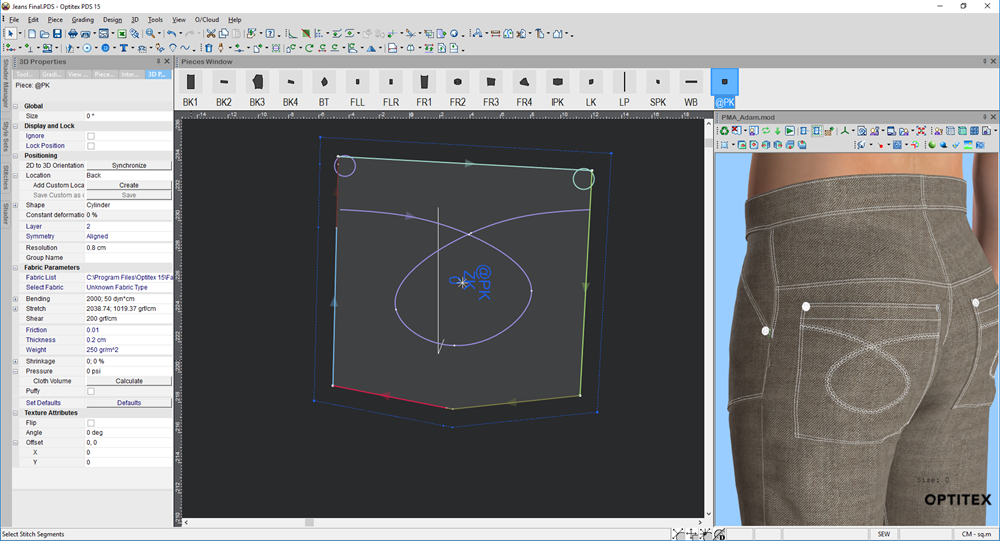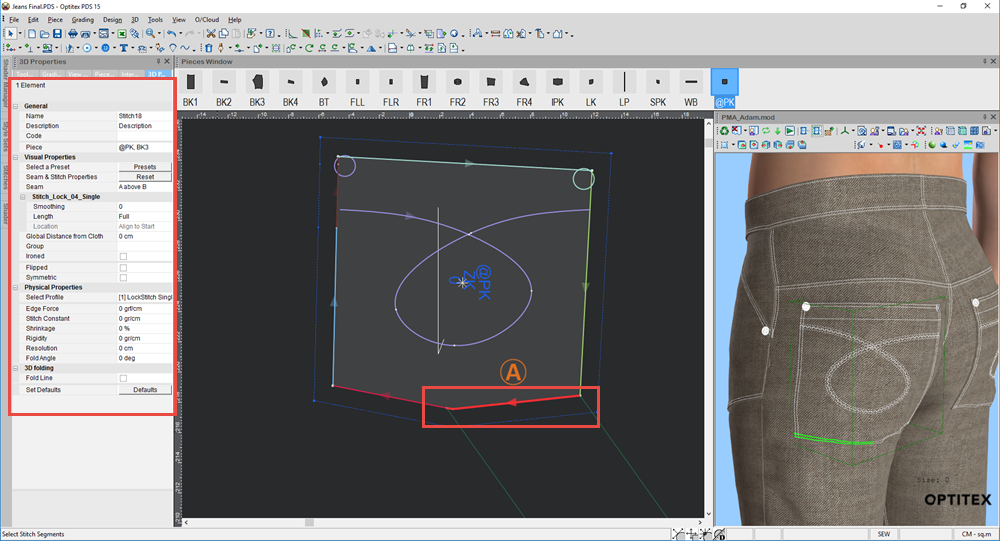Defining your Stitches Via Stitches Properties (O/15.6 or later)
Once you have created a stitch you can modify its attributes to define the stitch type, width, shape, parameters, etc.
There are different types of stitches, stitches that are not visible and those that are visible. Visible stitches which can be used as decorative stitches do not impact the mesh's triangulation.
Important: The stitch properties and the process for defining visual content on stitches has changed starting from O/15.6. If you are using an older version of Optitex, see Defining your Stitches Via Stitches Properties (Prior to O/15.6)
To define your stitches:
-
In the 3D window, click
 to turn on Stitch Mode.
to turn on Stitch Mode.
The stitches are displayed in different colors as follows:
-
Select a stitch.
The stitch is marked in red, and the 3D Properties dialog appears:
Enter the following information:
|
Field |
Description |
|
General |
|
|
Name |
Enter the stitch name. By default a system generated name is provided for all stitches by consecutive numbers, stitch1, stitch2, etc. You can modify this if required. |
|
Description |
Enter a short description for the stitch. |
|
Code |
Enter a descriptive code for the stitch, i.e., circular, straight, etc. |
|
Piece |
Displays the piece your stitch is located on. This is a read only field. |
|
Visual Properties |
|
|
Seam & Stitch Properties |
Click Presets to apply a preset to a stitch. You can select any of your presets without having to open the Seam & Stitch Manager. For more information, see Applying Presets Via the 3D Properties Dialog Note: This feature is available in version 15.6SP3 and later. Click Reset to remove all the seam and stitch properties you defined on the stitch. This removes all visual properties and returns the stitch to a basic stitch. Note: If you are viewing a basic stitch, this field is disabled. If visual properties were defined on the stitch, each component appears as a separate layer with the name of the component. The following attributes can be defined: Offset: Enter the distance of the stitch above or below the object's surface. Smoothing: Use the slider, or enter a value to set the smoothing level. Length: Enter the length of the stitch on the segment. Location: If the Length is less than Full, you can define the alignment of the stitch on the segment. From the drop-down list, select either Align to Start or Align to End. |
|
Seam |
Displays the seam type as it was defined in the Seam & Stitch Manager. |
|
Basic Stitch |
If the stitch was not defined, the stitch is a basic stitch and the following attributes can be defined: Offset: Enter the distance of the stitch above or below the object's surface. Smoothing: Use the slider, or enter a value to set the smoothing level. Length: Enter the length of the stitch on the segment. Location: If the Length is less than Full, you can define the alignment of the stitch on the segment. From the drop-down list, select either Align to Start or Align to End. |
|
Global Distance from Cloth |
Shifts all the components on the stitch according to a defined distance, relative to the Distance from Cloth parameter defined in the Seam & Stitch Manager. Note: This feature is available in version 15.6SP3 and later. |
|
If groups have already been defined, select the group from the drop-down list. Or if no groups have been defined, enter free text to create a group. If you want another stitch to belong the same group, repeat the same procedure for each stitch. This allows you to apply the same visual properties to a group of stitches. |
|
|
Ironed |
Select this checkbox, if you require a top stitch, or a crisp iron line such as creases, facings, pleats, or lapels. |
|
Flipped |
Select this checkbox, if you need to flip the direction of the stitch. |
|
Symmetric |
Select this checkbox, if you are stitching a piece to a paired piece. Notice that once the Symmetric definition is enabled, the Flipped definition is also enabled automatically. |
|
Physical Properties |
|
|
Select Profile |
|
|
Edge Force |
The Edge Force value is a force of specified weight (in grams) pulling the cloth in its direction. It is very sensitive and any slight change made to it can affect the simulation. The Edge Force value is directly effected by the cloth's physical attribute of stretch, and any change in this value will affect the way the Edge Force will work. As the Stretch value grows higher, the Edge Force value needed to pull the cloth also grows higher. |
|
Stitch Constant |
This value is meant to maintain the stitch in its original length. The higher the value, the less the stitch is going to be stretched during the simulation process. Stitch Const range is 0 to 400. Stitch Const value of 100 is a good standard for Double Needle. If you don’t set a Stitch Const value, the stitch will get the power of the fabric (the Stretch power – X or Y - the highest one between them). |
|
Shrinkage |
Enter the amount of shrinkage in a percentage % (from relaxed to finished). For example: 8 to 4 cm is 50% shrinkage. Use this value in cases where you need:
Note: This value is effected by the Stitch Const value. If the Stitch Const value is higher, then the Stitch will have more ‘Power’ to shrink. If the Stitch Const value is lower, the stitch will not have ‘Power’ to shrink. |
|
Rigidity |
Using the up and down arrows, set the rigidity of the stitch to define how rigid the stitch is relative to the fabric that stitches it together. A value of 1 indicates that the rigidity is similar to the fabric, while a value of 100 means the stitch is up to 100 times more rigid than the fabric. |
|
Resolution |
Enter the resolution of the stitch. This helps determine the size of the triangle's edges from which the stitch mesh is made of. If you lower this value you will get a high re-stitch. |
|
Fold Angle |
Enter the required fold angle in degrees. This allows you to set the angle between stitched surfaces. |
|
3D Folding |
|
|
Fold Line |
Select this checkbox, if you want to create a fold line, for example to fold a cuff, collar or lapel. |
|
Set Defaults |
Select Defaults if you want to return all properties to the default values. |